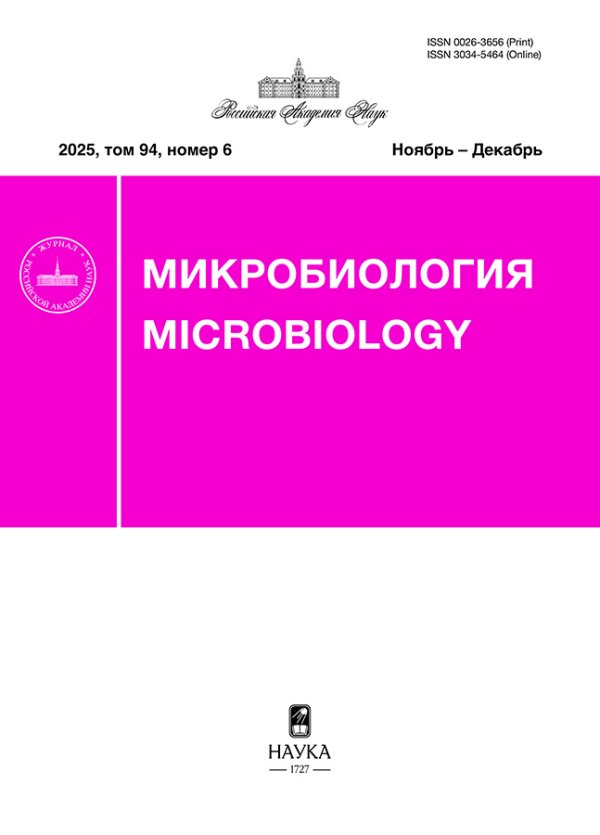Распространенность способности подавления роста родственных штаммов у ризобий
- Авторы: Баймиев А.Х.1, Владимирова А.А.1, Матниязов Р.Т.1, Лавина А.М.1, Филяева К.Ю.1, Акимова Е.С.1, Баймиев А.Х.1
-
Учреждения:
- Институт биохимии и генетики УФИЦ РАН
- Выпуск: Том 92, № 6 (2023)
- Страницы: 625-630
- Раздел: ЭКСПЕРИМЕНТАЛЬНЫЕ СТАТЬИ
- URL: https://journals.rcsi.science/0026-3656/article/view/231919
- DOI: https://doi.org/10.31857/S0026365623600311
- EDN: https://elibrary.ru/BSITVE
- ID: 231919
Цитировать
Полный текст
Аннотация
Проведен скрининг 1019 штаммов ризобий Rhizobium leguminosarum и Neorhizobium galegae из коллекции симбиотических ризосферных микроорганизмов “Симбионт” ИБГ УФИЦ РАН, изолированных из клубеньков 20 видов бобовых растений, на способность подавлять рост родственных штаммов ризобий. Исследования показали, что подавление роста конкурирующих бактерий ризобиями довольно распространенное явление. В среднем, при выращивании на богатых средах около 10% штаммов ризобий выделяли в среду антибактериальные вещества. Отмечено, что когда на газон бактерий наносилась живая культура ризобий, процент подавления был выше. Также процент штаммов, синтезирующих антибактериальные вещества, в некоторой степени соотносится с уровнем генетического разнообразия популяции микросимбионтов бобового растения. Слабый сигнал нарушения синтеза белка обнаружен при исследовании механизма действия метаболитов 20 штаммов ризобий R. leguminosarum bv. viciae из клубеньков чины болотной и чины весенней. В остальных случаях характер антибактериального действия метаболитов бактерий с применением системы D-ualRep2 определить не удалось.
Ключевые слова
Об авторах
Ал. Х. Баймиев
Институт биохимии и генетики УФИЦ РАН
Автор, ответственный за переписку.
Email: baymiev@mail.ru
Россия, 450054, Уфа
А. А. Владимирова
Институт биохимии и генетики УФИЦ РАН
Email: baymiev@mail.ru
Россия, 450054, Уфа
Р. Т. Матниязов
Институт биохимии и генетики УФИЦ РАН
Email: baymiev@mail.ru
Россия, 450054, Уфа
А. М. Лавина
Институт биохимии и генетики УФИЦ РАН
Email: baymiev@mail.ru
Россия, 450054, Уфа
К. Ю. Филяева
Институт биохимии и генетики УФИЦ РАН
Email: baymiev@mail.ru
Россия, 450054, Уфа
Е. С. Акимова
Институт биохимии и генетики УФИЦ РАН
Email: baymiev@mail.ru
Россия, 450054, Уфа
Ан. Х. Баймиев
Институт биохимии и генетики УФИЦ РАН
Email: baymiev@mail.ru
Россия, 450054, Уфа
Список литературы
- Баймиев Ан.Х., Иванова Е.С., Птицын К.Г., Белимов А.А., Сафронова В.И., Баймиев Ал.Х. Генетическая характеристика клубеньковых бактерий дикорастущих бобовых Южного Урала // Мол. генет. микробиол. вирусол. 2012. Т. 27. С. 29‒34.
- Baimiev An.K., Ivanova E.S., Ptitsyn K.G., Belimov A.A., Safronova V.I., Baimiev Al.K. Genetic characterization of wild leguminous nodular bacteria living in the South Urals // Mol. Genet. Microbiol. Virol. 2012. V. 27. P. 33‒39.
- Baba T., Mori H. The construction of systematic in-frame, single-gene knockout mutant collection in Escherichia coli K-12 // In Microbial Gene Essentiality: Protocols and Bioinformatics / Methods in Molecular Biology: Humana Press, 2008. P. 171–181.
- Fuqua W.C., Winans S.C., Greenberg E.P. Quorum sensing in bacteria: the LuxR-LuxI family of cell density-responsive transcriptional regulators // J. Bacteriol. 1994. V. 176. P. 269–275.
- Hirsch P.R. Plasmid-determined bacteriocin production by Rhizobium leguminosarum // J. Gen. Microbiol. 1979. V. 113. P. 219–228.
- Lethbridge B.J., Asenstorfer R.E., Bailey L.S., Breil B.T., Johnson J.V., Jones G.P., Rumjanek V., Sims J.J., Tate M.E., Triplett E.W. Post translational modifications of Trifolitoxin: a blue fluorescent peptide antibiotic // J. Antibiotics. 2022. V. 75. P. 125–135.
- Osterman I.A., Komarova E.S., Shiryaev D.I., Korniltsev I.A., Khven I.M., Lukyanov D.A., Tashlitsky V.N., Serebryakova M.V., Efremenkova O.V., Ivanenkov Y.A., Bogdanov A.A., Sergiev P.V., Dontsova O.A. Sorting out antibiotics’ mechanisms of action: a double fluorescent protein reporter for high-throughput screening of ribosome and DNA biosynthesis inhibitors // Antimicrob. Agents Chemother. 2016. V. 60. P. 7481–7489.
- Schwinghamer E.A. Properties of some bacteriocins produced by Rhizobium trifolii // J. Gen Microbiol. 1975. V. 91. P. 403‒413.
- Schwinghamer E.A., Brockwell J. Competitive advantage of bacteriocin and phage-producing strains of Rhizobium trifolii in mixed culture // Soil Biol. Biochem. 1978. V. 10. P. 383–387.
- Schwinghamer E.A., Pankhurst C.E., Whitfeld P.R. A phage-like bacteriocin of Rhizobium trifolii // Can. J. Microbiol. 1973. V. 19. P. 359‒368.
- Travin D.Y., Jouan R., Vigouroux A., Inaba-Inoue S., Lachat J., Haq F., Timchenko T., Sutormin D., Dubiley S., Beis K., Moréra S., Severinov K., Mergaert P. Dual-uptake mode of the antibiotic phazolicin prevents resistance acquisition by gram-negative bacteria // mBio. 2023. V. 14. P. e00217‒23.
- Travin D.Y., Watson Z.L., Metelev M., Ward F.R., Osterman I.A., Khven I.M., Khabibullina N.F., Serebryakova M., Mergaert P., Polikanov Y.S., Cate J.H.D., Severinov K. Structure of ribosome-bound azole-modified peptide phazolicin rationalizes its species-specific mode of bacterial translation inhibition // Nat. Commun. 2019. V. 10. P. 4563.
- Triplett E.W., Barta T.M. Trifolitoxin production and nodulation are necessary for the expression of superior nodulation competitiveness by Rhizobium leguminosarum bv. trifolii strain T24 on clover // Plant. Physiol. 1987. V. 85. P. 335‒342.
Дополнительные файлы















